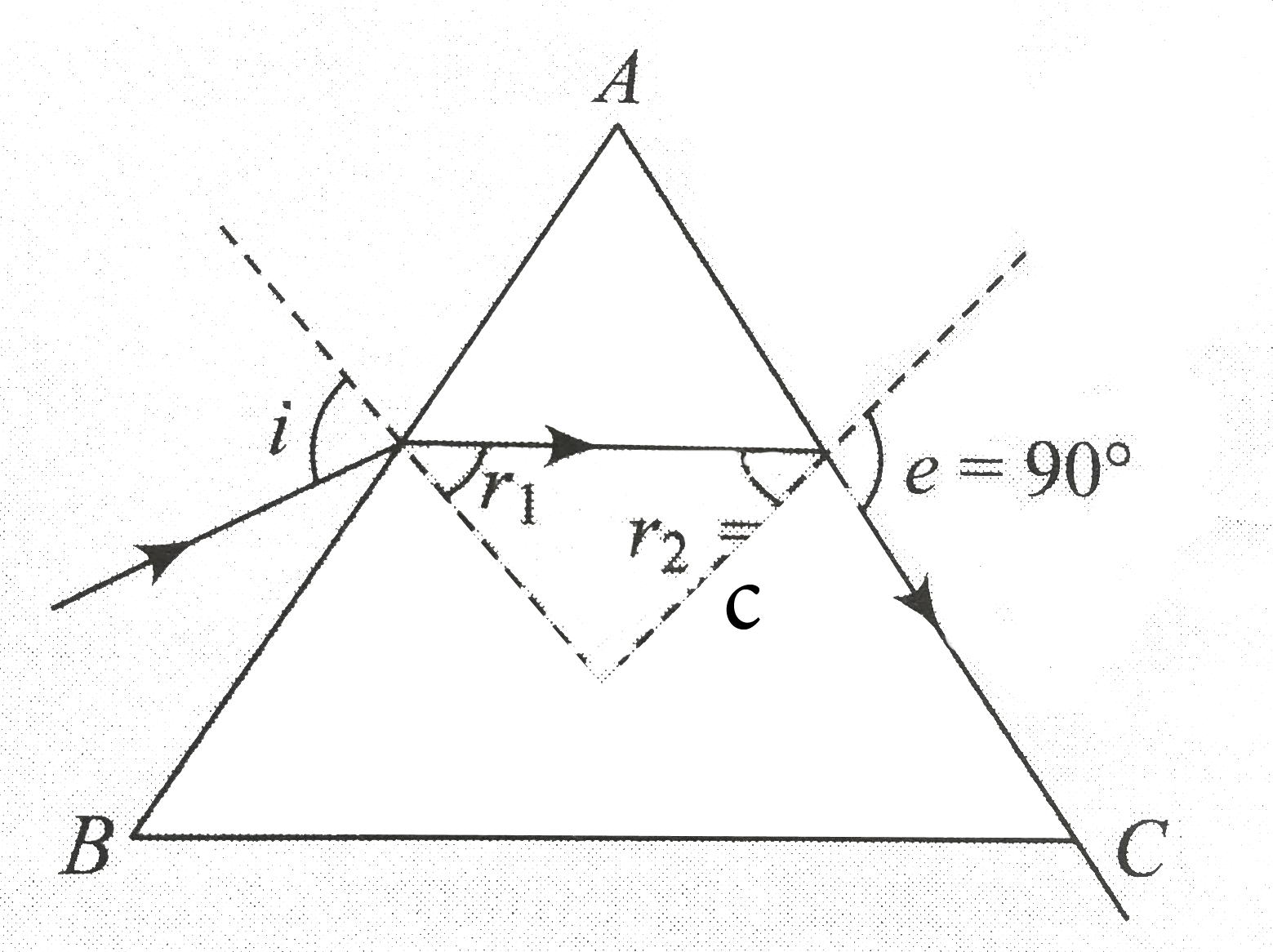The refractive index of the material of a prism of refracting angle 45∘ is 1.6 for a certain monochromatic ray. What will be the minimum angle of incidence of this ray on the prism so that no TIR takes place as the ray comes out of the prism.
To solve the problem step by step, we will follow these steps:
Step 1: Understand the Problem
We need to find the minimum angle of incidence (I) for a monochromatic ray entering a prism with a refracting angle of 45° and a refractive index of 1.6, such that no Total Internal Reflection (TIR) occurs when the ray exits the prism.
Step 2: Determine the Critical Angle
The critical angle (θc) can be calculated using the formula:
θc=sin−1(μ1μ2)
where:
- μ1 = refractive index of air = 1
- μ2 = refractive index of the prism = 1.6
Calculating the critical angle:
θc=sin−1(11.6)≈38.7∘
Step 3: Relate Angles in the Prism
For a prism, the relationship between the angle of incidence (I), angle of refraction (r1), and the prism angle (A) is given by:
r1+r2=A
where:
- A=45∘ (the refracting angle of the prism)
- r2 is the angle of refraction as the ray exits the prism.
Step 4: Condition for No TIR
To avoid TIR at the exit point, the angle of refraction r2 must be less than or equal to the critical angle:
r2≤θc
Substituting the expression for r2:
r2=45∘−r1≤38.7∘
Step 5: Solve for r1
From the inequality:
45∘−r1≤38.7∘
Rearranging gives:
r1≥45∘−38.7∘=6.3∘
Step 6: Use Snell's Law
Now, we apply Snell's Law at the first surface of the prism:
sinI=μ⋅sinr1
Substituting μ=1.6:
sinI=1.6⋅sinr1
Step 7: Substitute Minimum r1
Using the minimum value of r1=6.3∘:
sinI=1.6⋅sin(6.3∘)
Calculating sin(6.3∘):
sin(6.3∘)≈0.109
Thus:
sinI=1.6⋅0.109≈0.1744
Step 8: Find Minimum Angle of Incidence
Now, calculate the angle of incidence I:
I=sin−1(0.1744)≈10.0∘
Step 9: Conclusion
The minimum angle of incidence I such that no TIR occurs as the ray exits the prism is approximately:
I≈10.0∘
---
We need to find the minimum angle of incidence (I) for a monochromatic ray entering a prism with a refracting angle of 45° and a refractive index of 1.6, such that no Total Internal Reflection (TIR) occurs when the ray exits the prism.
The critical angle (θc) can be calculated using the formula:
θc=sin−1(μ1μ2)
where:
- μ1 = refractive index of air = 1
- μ2 = refractive index of the prism = 1.6
θc=sin−1(11.6)≈38.7∘
For a prism, the relationship between the angle of incidence (I), angle of refraction (r1), and the prism angle (A) is given by:
r1+r2=A
where:
- A=45∘ (the refracting angle of the prism)
- r2 is the angle of refraction as the ray exits the prism.
To avoid TIR at the exit point, the angle of refraction r2 must be less than or equal to the critical angle:
r2≤θc
Substituting the expression for r2:
r2=45∘−r1≤38.7∘
From the inequality:
45∘−r1≤38.7∘
Rearranging gives:
r1≥45∘−38.7∘=6.3∘
Now, we apply Snell's Law at the first surface of the prism:
sinI=μ⋅sinr1
Substituting μ=1.6:
sinI=1.6⋅sinr1
Using the minimum value of r1=6.3∘:
sinI=1.6⋅sin(6.3∘)
sin(6.3∘)≈0.109
Thus:
sinI=1.6⋅0.109≈0.1744
Now, calculate the angle of incidence I:
I=sin−1(0.1744)≈10.0∘
The minimum angle of incidence I such that no TIR occurs as the ray exits the prism is approximately:
I≈10.0∘
Topper's Solved these Questions
- REFRACTION OF LIGHTBOOK - DC PANDEY ENGLISHCHAPTER - REFRACTION OF LIGHTEXERCISE - Level 1 Assertion And Reason
13 Videos
- REFRACTION OF LIGHTBOOK - DC PANDEY ENGLISHCHAPTER - REFRACTION OF LIGHTEXERCISE - Level 1 Objective
38 Videos
- REFRACTION OF LIGHTBOOK - DC PANDEY ENGLISHCHAPTER - REFRACTION OF LIGHTEXERCISE - Exercise 31.7
2 Videos
- REFLECTION OF LIGHTBOOK - DC PANDEY ENGLISHCHAPTER - REFLECTION OF LIGHTEXERCISE - Subjective
9 Videos
- SEMICONDUCTORSBOOK - DC PANDEY ENGLISHCHAPTER - SEMICONDUCTORSEXERCISE - Subjective
12 Videos
Similar Questions
The refractive index of the material of prism √3, then the angle of minimum deviation of prism is
View SolutionWhat should be the minimum value of refractive index of a prism, refracting angle A, so that there is no emergent ray irrespective of the angle of incidence?

View SolutionThe refractive index of material of a prism of angles 45∘, −45∘, and −90∘ is 1.5. The path of the ray of light incident normally on the hypotenuse side shown in
View SolutionWhat is the angle of incidence for an equilateral prism of refractive index √3 so that the ray si parallel to the base inside the prism?
View SolutionRefractive index of a prism is √7/3 and the angle of prism is 60∘. The minimum angle of incidence of a ray that will be transmitted through the prism is
View SolutionA ray of light is normally incident on one face of an equilateral glass prism. Answer the following :
(a) What is the angle of incidence on the first face of the prism?
(b) What is the angle of refraction from the first face of the prism ?
(c) What will be the angle of incidence at the second face of the prism ?
(d) Will the light ray suffer minimum deviation by the prism ?
View SolutionIf the angle of minimum deviation is of 60∘ for an equilateral prism , then the refractive index of the material of the prism is
View SolutionA ray of monochromatic light is incident on one refracting face of a prism of angle 75∘. It passes thorugh the prism and is incident on the other face at the critical angle. If the refractive index of the material of the prism is √2, the angle of incidence on the first face of the prism is
View SolutionThe refracting angle of a prism is A and refractive index of the material of prism is cot(A/2) . The angle of minimum deviation will be
View SolutionThe refracting angle of a prism is A and refractive index of the material of prism is cot(A/2) . The angle of minimum deviation will be
View Solution
